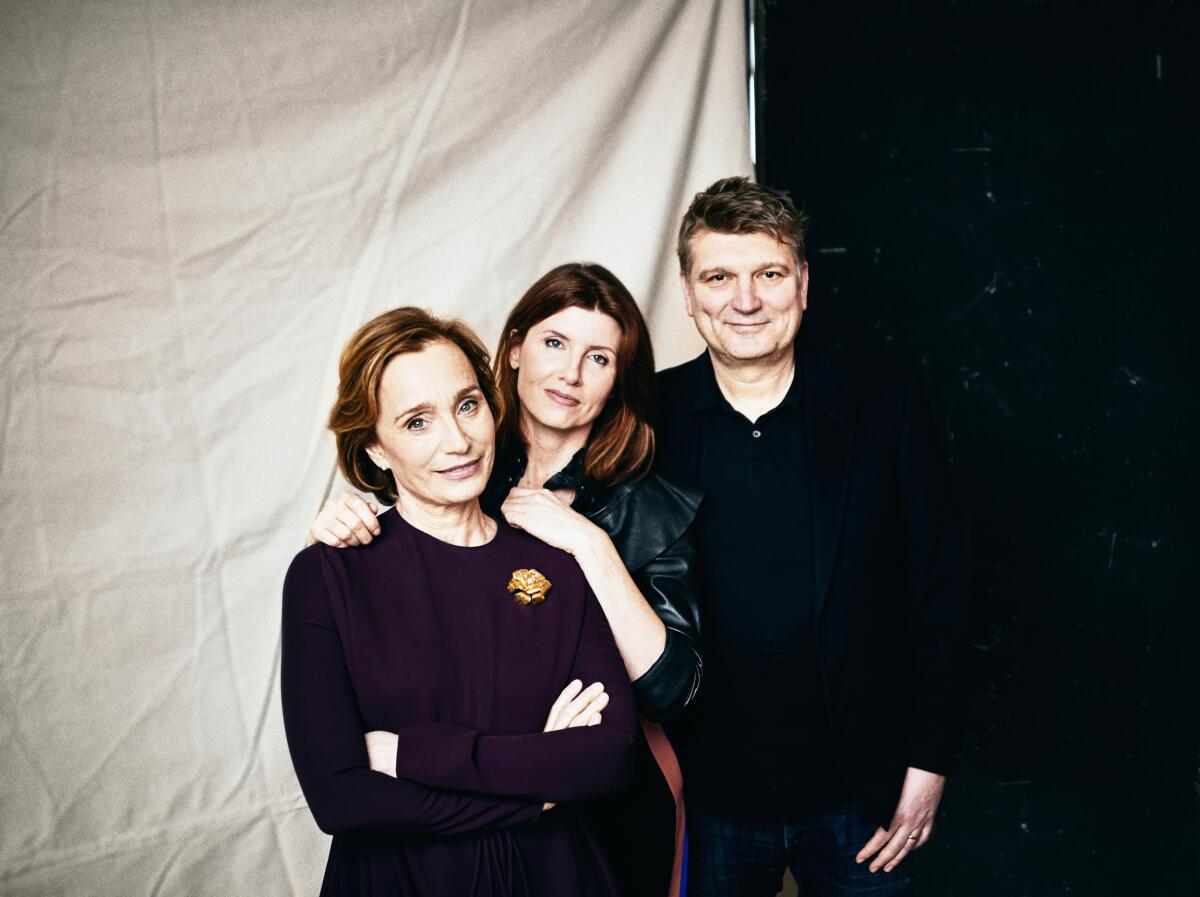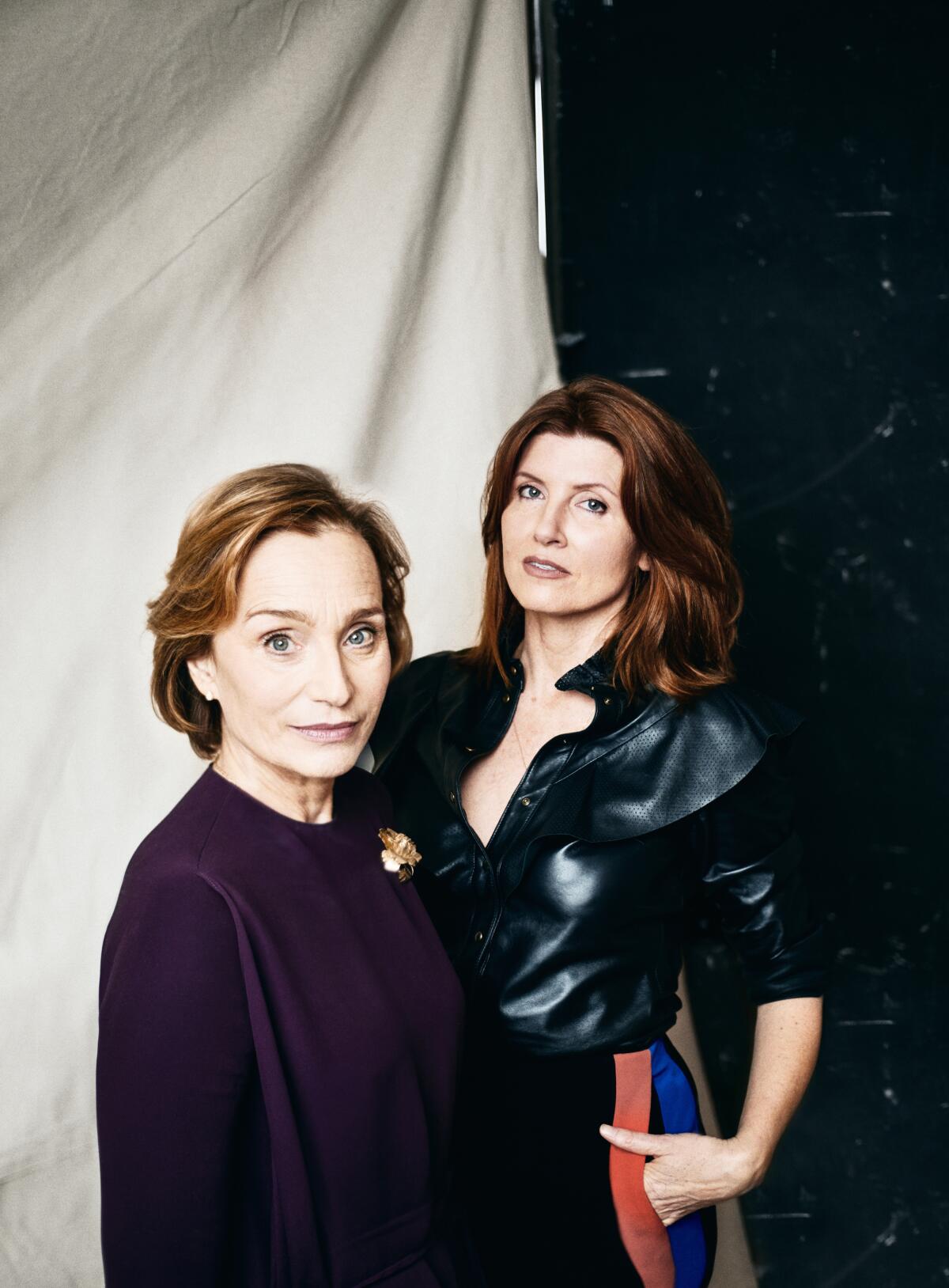23 years after the sleeper success of ‘The Full Monty,’ Peter Cattaneo turns to ‘Military Wives’

- Share via
LONDON — In 1997, Peter Cattaneo’s directorial debut “The Full Monty” swept the box office before winning the BAFTA for best film and scoring four Oscar nominations, including for directing. It was a whirlwind time for the British filmmaker, whose first child was born only days before the Academy Awards, and he spent years afterward trying to live up to the success of his first feature.
He ended up directing a few more movies, including 2008’s “The Rocker,” but for the past decade Cattaneo has made his career in TV rather than cinema. It’s only now, with uplifting film “Military Wives,” which is available on Hulu and via video-on-demand platforms, that the director has returned to his original form.
“It’s so lovely to have done something that connected with people so much,” Cattaneo says of “The Full Monty,” sitting in a production office in London in February before the shutdown. “But I didn’t know how the hell to follow it. It was my first film, and I just kept coming up with ideas, but they weren’t as good. It was crippling because everything was going to be a step down. It took me about 10 years of making not-as-good films to get over it and forget about it.”
“Military Wives,” set on an army base in the north of England, has a similar flavor to “The Full Monty,” and it’s also about average people coming together to lift themselves up. Based loosely on Gareth Malone’s BBC documentary “The Choir,” the film follows a group of spouses living on the fictional Flitcroft Garrison as their partners are deployed to Afghanistan. Instead of wallowing, the women decide to form a choir, which becomes their lifeline through the crisis.
Cattaneo came onboard nearly four years ago, before the script was finalized, and it was the documentary that convinced him there was a genuine story to tell.
“I’ve been sent so many of this type of script over the years,” the director notes. “I get sent endless ‘Full Monty’-type scripts — and this is another one, really. But when I actually met the people, I realized it has its own inner life. It wasn’t just a construct. The camera normally goes off with the soldiers, but to stay behind and see what happens is compelling.
“What happens in that little gap? What happens in those shadows? That felt really fascinating. You start meeting the women and hearing their stories, and it’s a very rich world.”
While the film, written by Rachel Tunnard and Rosanne Flynn, is fictionalized, many of the characters and narrative arcs are based on real women and their lives (there are now 75 military choirs in the U.K.). The screenwriters met with several actual wives, and the movie was shot primarily at Catterick Garrison in North Yorkshire — the actual home of the first military wives choir. Cattaneo even used the base’s inhabitants as extras in several scenes.
Casting was key for Catteneo, who didn’t want to fill the movie with Broadway-level singers. The filmmakers went out to Oscar nominee Kristin Scott Thomas and “Catastrophe” creator Sharon Horgan simultaneously, who both quickly agreed to be part of the film, and then expanded the cast with an ensemble that reflects the sorts of women who would actually be living on a base.
“I was always super worried about it becoming ‘Mamma Mia’ — not that I don’t love ‘Mamma Mia,’” Cattaneo says. “I didn’t want it to become plastic or where they all break into song as an amazing choir. I wanted it to be — especially at first — pretty bad singing. … I was massively determined to make each one completely memorable to stand out. It was just a case of meeting lots of colorful actresses who felt real and not actor-y. People with different accents. All the cast, in the end, are not great singers. They’re competent singers.”
Due to budget constraints, Cattaneo was given only five weeks to shoot. He wanted to film the scenes primarily in chronological order so the choir would naturally improve over the course of shooting, all leading up to a grand finale performance in Royal Albert Hall. There were two days of initial rehearsals to break the ice, but after that Cattaneo insisted the actors refrain from singing rehearsals.
“I wanted that messiness,” he explains. “Basically, I stopped them rehearsing as much as I could. We shot those scenes with two or three cameras so we could get through it very quickly where it feels alive in the room. The shots are a bit scrappy, but that was the only way to do it, with as few takes as possible.”
He laughs, adding, “And then I’d be wandering around this base and I’d hear secret rehearsals going on.”

“He didn’t want it to sound like a bunch of actors who probably did some singing training at drama school,” says Horgan. “Of course, there would be some natural singers in there, but for the most part it’s just regular women trying to take their minds off what’s going on in Afghanistan.
“He wanted us to learn on the job. And I think it worked. We were genuinely in awe and delighted that we sounded as good as we did in the final scenes, and I think that’s how the women must have felt.”
The selection of songs was key, and Cattaneo spent hours digging through Spotify. The tracks needed to resonate, but they couldn’t slip into pure cheese. That balance was important throughout the entire film, and Cattaneo focused on how to “steer that tonal line between being feel-good, uplifting and fun, and keeping its feet on the ground to undercut it when we can.” Ultimately “Military Wives” is both funny and sad, reminding us that we can create something bigger than ourselves when we come together.
“It’s difficult not to make a film with songs in it sentimental,” Scott Thomas says. “We wanted to avoid anything that was too on the nose, even though the whole story is on the nose, if you know what I mean. It’s a choir whose goal is to become good and sing at Royal Albert Hall — that’s a fairy tale in itself. You’ve got to hold back a bit to make that kind of thing believable and likable. Peter was a very, very good captain on that. He managed to sail us along quite well from that dangerous thing.”
“He’s very good at this kind of thing,” Horgan adds. “On the surface, there’s a simplicity to the story, but it’s very easy to get these kinds of films wrong. It’s easy to lean into the emotion of it too heavily. It’s easy for it to become schmaltzy. How do you find your way into singing and songs without it standing too proud? How do you make people relate to these lives as lives that are completely different from your own but still relatable? He just has a really light hand with that kind of thing.”
For Cattaneo, “Military Wives” was an opportunity to remember the joys of filmmaking. He says “Military Wives” — which had its world premiere at last year’s Toronto International Film Festival and opened in theaters in the U.K., Australia and New Zealand earlier this year before COVID-19 shut down cinemas — allowed him to recapture that feel-good spirit he created in “The Full Monty.”
“I like all sorts of film, but basically I like to see a film that makes you feel better about life after you’ve seen it,” Cattaneo says. “And that’s true if I’m going to spend a year of my life making a film. I do feel like I’ve got the bug back. It’s been so nice. There’s nothing like when the lights go down and all those people are there to give you two hours of their time.”
More to Read
Only good movies
Get the Indie Focus newsletter, Mark Olsen's weekly guide to the world of cinema.
You may occasionally receive promotional content from the Los Angeles Times.










